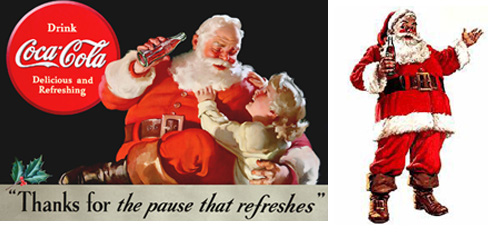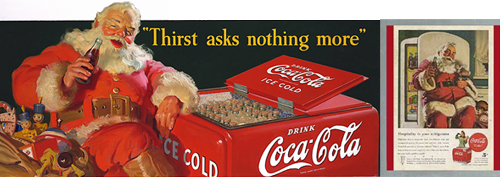 Legend has it that the modern Santa Claus was created by Coca Cola back in the 1930s as part of a national advertising campaign. As part of this theory, it was also widely believed that that Santa’s red and white colors were chosen for one reason—to promote the Coke brand.
Legend has it that the modern Santa Claus was created by Coca Cola back in the 1930s as part of a national advertising campaign. As part of this theory, it was also widely believed that that Santa’s red and white colors were chosen for one reason—to promote the Coke brand.
It sounds good—our premier Christmas image created by an American marketing machine—but it’s not completely true.
As mentioned in an earlier post, the Santa image had been evolving for years. By the late 19th century, Santa was still portrayed in many lights– as large and slight build, sometimes chubby, sometimes not; sometimes jolly, sometimes serious. His clothes might be red, purple or green (when Louis Prang created a Santa Claus Christmas card in 1885, he was wearing a red suit)
Still, there was a look emerging. By the time Norman Rockwell was painting Santas in the 1920s (picture below on left), Santa’s makeover was pretty complete and universally recognized. The bushy eyebrows, chubby physique, white beard, sacks of toys—all were in place by the time Coca Cola got its hands on Santa.
 You could also see this Santa image depicted for years in Christmas cards (see above middle and right).
You could also see this Santa image depicted for years in Christmas cards (see above middle and right).
Chalk it up as an urban legend, as this site points out:
“Although some versions of the Santa Claus figure still had him attired in various colors of outfits past the beginning of the 20th century, the jolly, ruddy, sack-carrying Santa with a red suit and flowing white whiskers had become the standard image of Santa Claus by the 1920s, several years before Sundlom drew his first Santa illustration for Coca-Cola. As The New York Times reported on 27 November 1927:
A standardized Santa Claus appears to New York children. Height, weight, stature are almost exactly standardized, as are the red garments, the hood and the white whiskers. The pack full of toys, ruddy cheeks and nose, bushy eyebrows and a jolly, paunchy effect are also inevitable parts of the requisite make-up.”
In fact, according to Wikipedia, Coca-Cola was not even the first soft drink company to utilize the modern image Santa Claus in its advertising – White Rock Beverages used Santa in advertisements for its ginger ale in 1923 after first using him to sell mineral water in 1915.
What Coke did do was give us a consistent, standardized look, while promoting an image that would spread across the globe. While they didn’t invent the red-clothed Santa, their massive campaign was one of the main reasons for that Santa Claus is depicted even today as wearing red and white.
It was during the Great Depression, and Coke hired a talented Chicago illustrator (Haddon Sundblom) to create a Christmas advertising campaign. Times were tough and Coca-Cola needed ways to increase sales of their product during the usually slow winter season.
Sundblom enhanced Santa’s image, making him about two feet taller, 100 pounds heavier and featuring a new personality. This Santa would be good natured, jolly and a breath of fresh air for those suffering in tough times. Santa appeared in a gleaming red outfit. Sundblom’s version was a full-sized human (no more elf figures) with a plump belly and a pleasant face. One writer described him as a “kindly uncle who enjoys his work. He raids the refrigerator and takes time to play with the family dog.”
The “new Santa” became part of Coke’s annual advertisements, which featured him drinking Coke, giving Coke as a gift, and enjoying the drink in different ways. It worked. Coke’s sales surged during the winter, and the new perennial feature helped the burgeoning company expand its sales to children (to the dismay later of parents).
Sundblom’s annual painting from 1931 through 1964 evolved into the “traditional” Santa that many of us grew up with.
As far as the red and white colors being a Coca-Cola brand-driven conspiracy, remember that most of the depictions by the late 1800s had him in these colors. And turns out there is some historical basis for a red and white Santa. The colors go all the way back to Santa’s ancestors, particularly Saint Nicholas, Bishop of Myra (and Bari) (see post) Hundreds of years before anyone had even heard of a Coke, these people were typically clothed in the traditional red colored bishop robes. Coca Cola may have standardized and popularized the new Santa, but the color issue is a (excuse the pun) red herring.
More history and material on the commercialization of Santa on this site.

